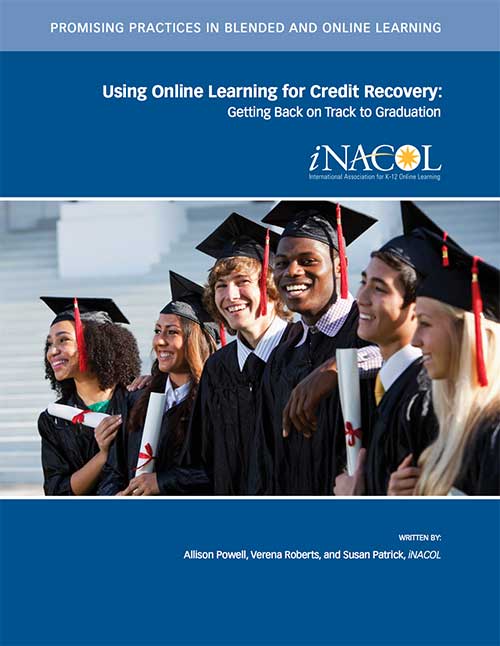Report
Using Online Learning for Credit Recovery: Getting Back on Track to Graduation

This research paper illustrates how schools and programs are using online learning to provide credit recovery for students with a wide spectrum of academic needs. The report investigates credit recovery and its impact on today’s students, state and district approaches to providing credit recovery, as well as case studies of exemplar programs and lessons learned.
In 2008, iNACOL published a series of Promising Practices papers in K-12 blended and online learning. In the last five years, transformative policy and practice changes accelerated the shift toward personalized learning and iNACOL is updating the promising practices research for pioneering educators and policy makers working toward transformed, student-centered learning environments.
Our country has been trying to address the graduation crisis in many ways. We are seeing the impact of the efforts to improve graduation rates over the past twenty years including agreement among states to implement a common cohort-based graduation rate, research-based efforts to improve the transition to 9th grade, increased academic and social supports, individualized instruction, effective use of educational technology and building new capacity of districts to provide multiple pathways to graduation including re-engagement centers so young people that had previously disengaged from school can re-enroll in school to complete their diplomas.
Initially, when students were over-age and under-credited, school districts had to depend on alternative schools designed for students that need more support and/or flexibility, and used by students that may have disengaged from school, seeking a different learning environment or pushed out through disciplinary policies. With online and blended learning, districts are beginning to develop flexibly paced credit recovery to help students stay on track to graduation instead of finding themselves in senior year with no way to graduate. Alternative schools like other schools have been integrating online learning to create more options for students.
Today, one of the root issues is the older students who are missing a significant number of credits do not have the time to sit in class again, thus competency-based programs are a better option. Online learning is inherently modular. Allowing more time to build mastery and experience smaller successes along the way would also function to prevent huge gaps in their learning that ultimately requires them to retake full courses today.
At the heart of the issue, when students have gaps in learning, competency-based education approaches can let kids focus in more closely on where there are gaps in learning—rather than waiting until students have to catch up by re-enrolling in entire credits. Just focusing on making up credits may not help them strengthen their skills. Adaptive learning and educational software can really help students strengthen their basic foundational skills and increase fluency on the lower levels of Bloom’s taxonomy on appropriate learning goals. But, that is not enough. Students need to be able to engage in higher order thinking skills and demonstrate deeper learning to build their analytical, evaluation, synthesis and be able to apply their learning on the higher levels of Bloom’s taxonomy. It is important for students to get to the higher levels of depth of knowledge, and an especially critical issue for kids who are having trouble in school. It is important that our system begin to transform around the needs of students.
To ensure success, the focus should be on how we help students graduate with the skills to be successful in life.